Fujitsu Client Computing WB0029 LIFEBOOK T SERIES W/ WLL4070 11ABG WLAN & BT User Manual Appendix I 1
Fujitsu Limited LIFEBOOK T SERIES W/ WLL4070 11ABG WLAN & BT Appendix I 1
Contents
- 1. User manual part 1
- 2. User manual part 2
- 3. User manual part 3
- 4. User Manual part 1
User manual part 1
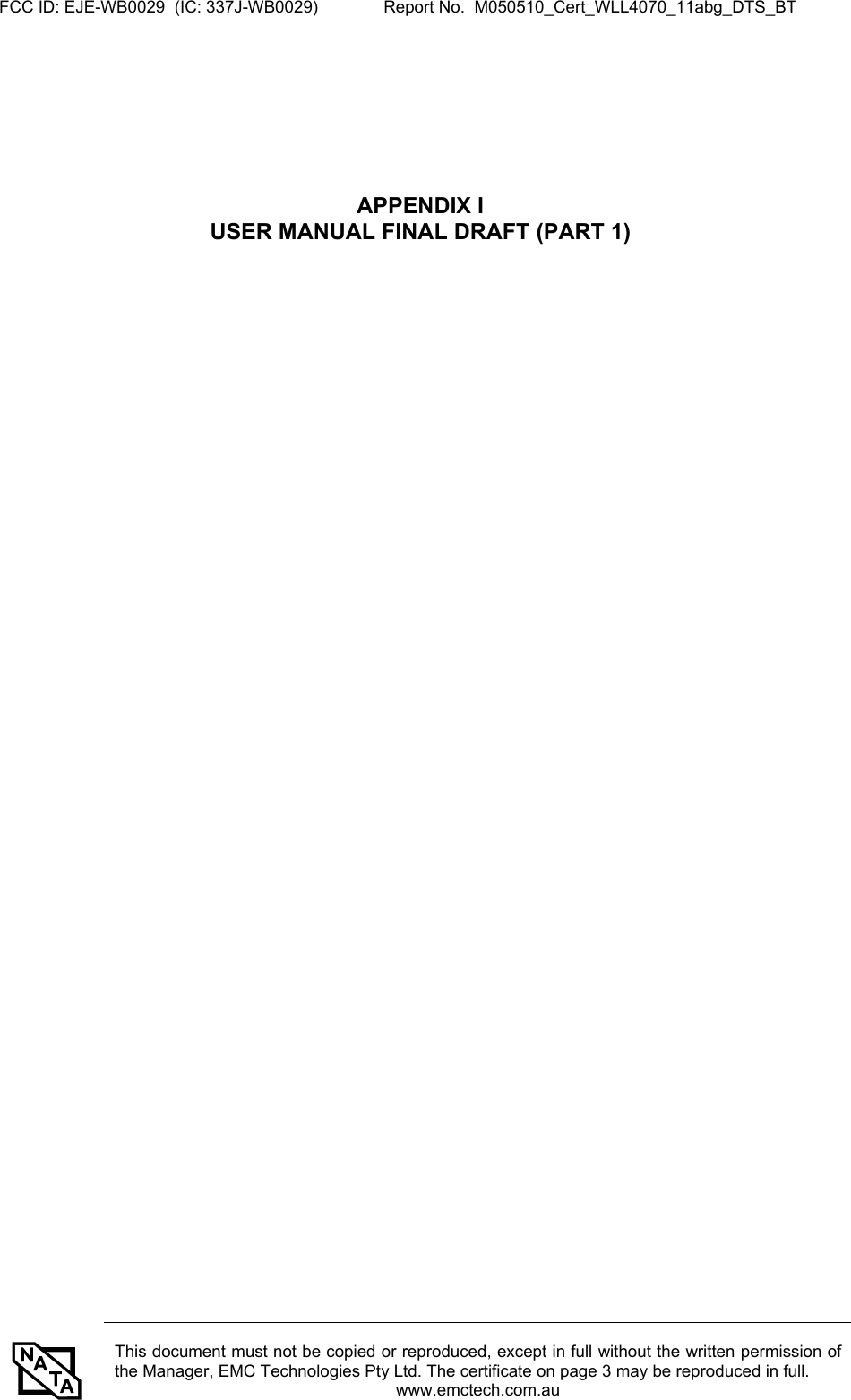
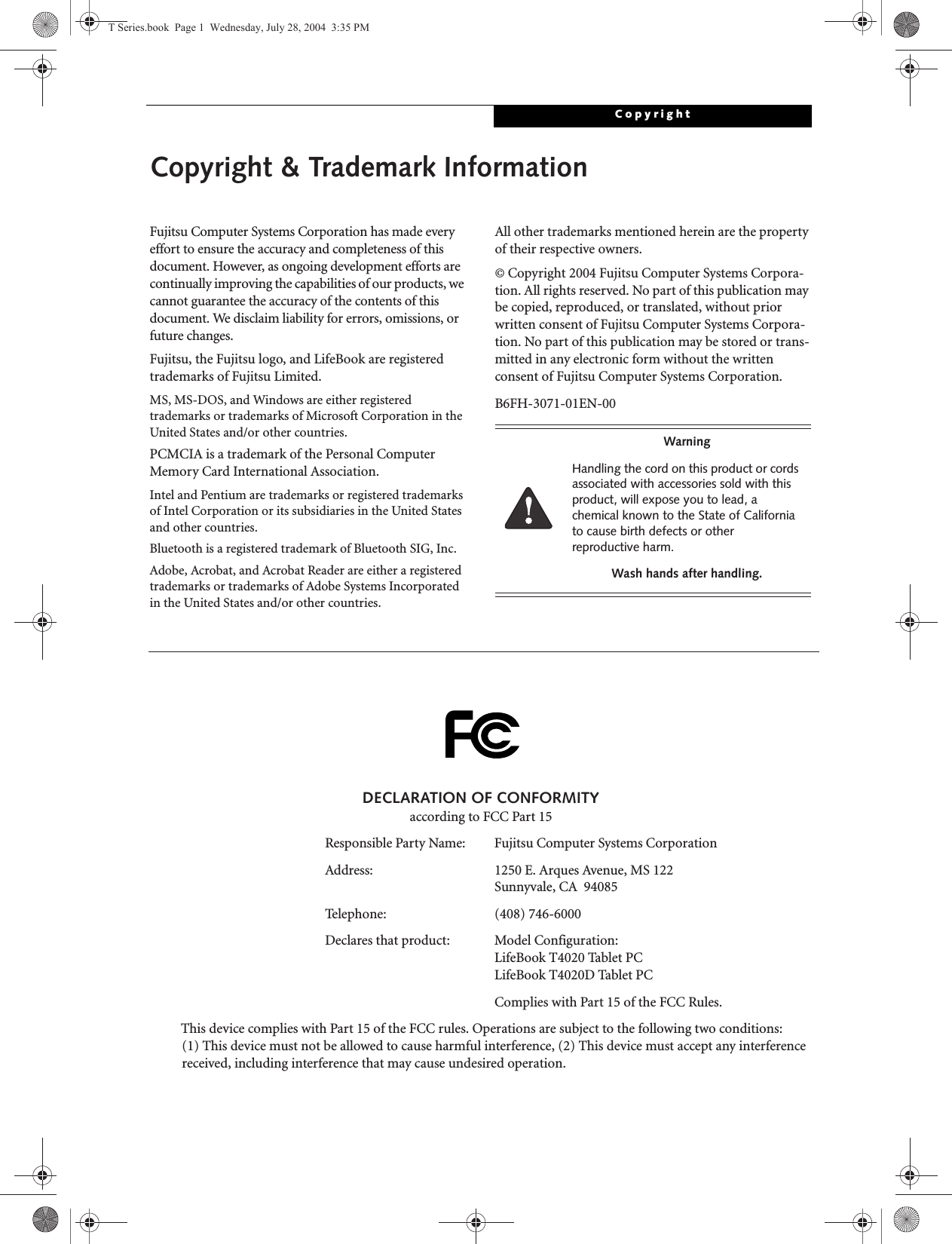
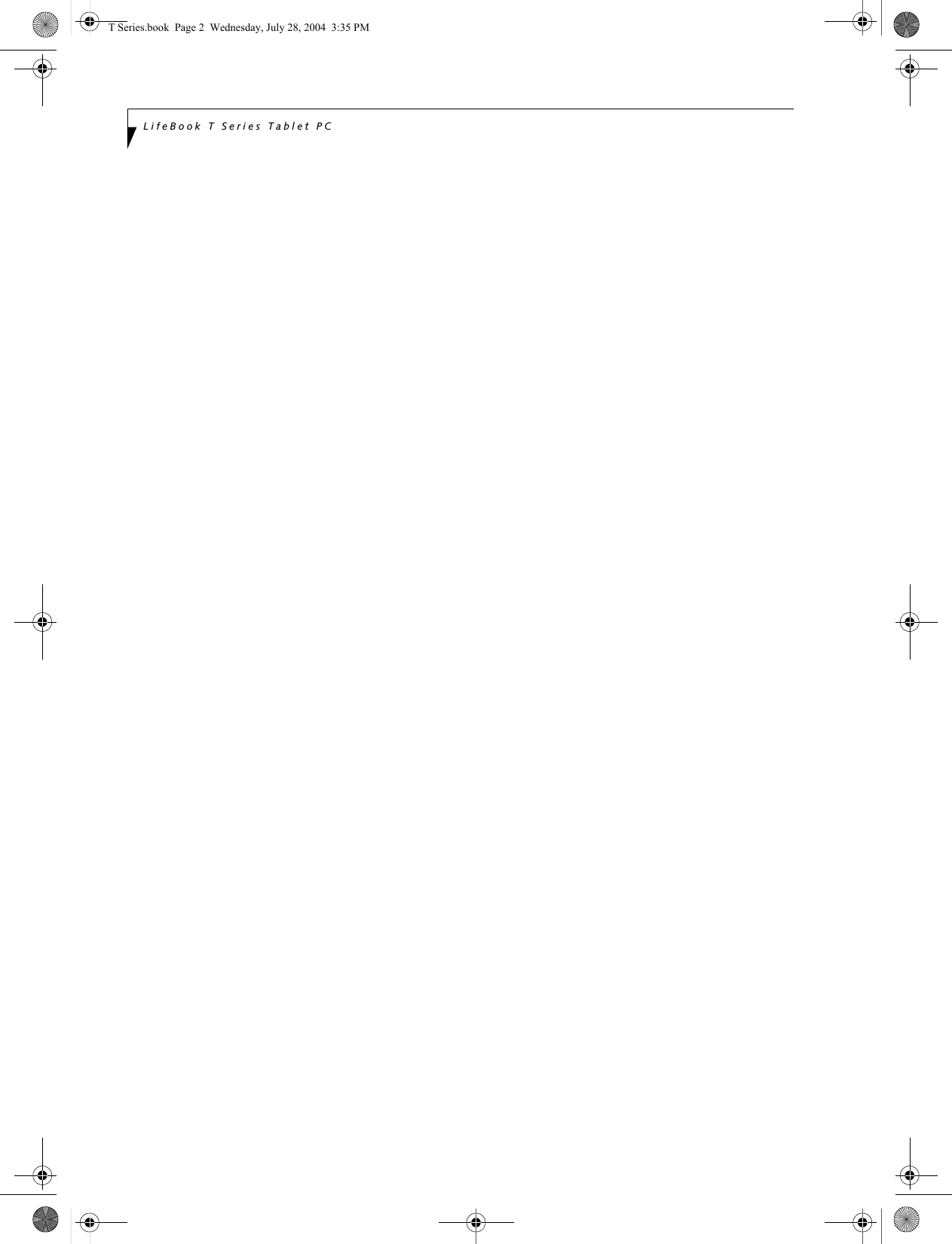
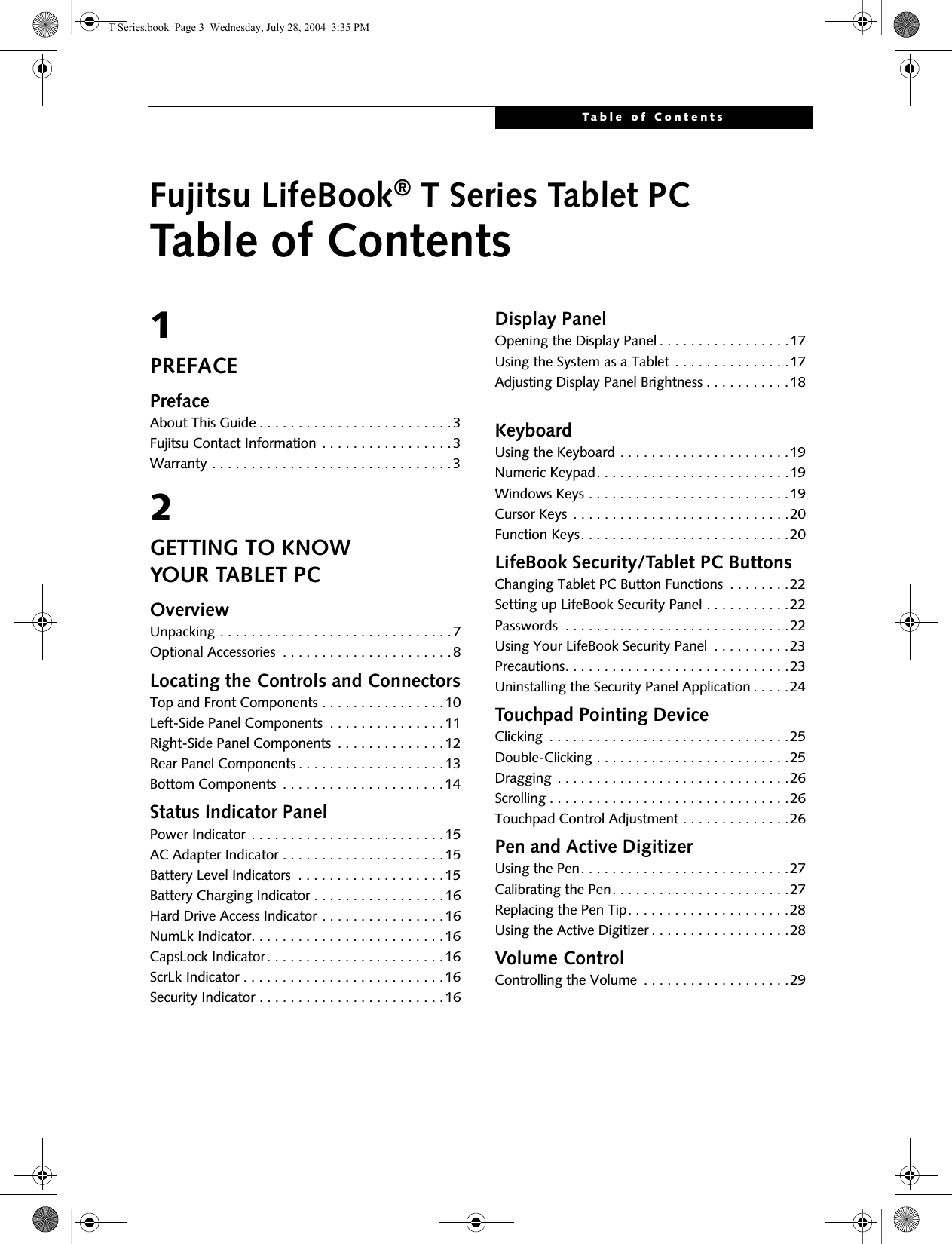
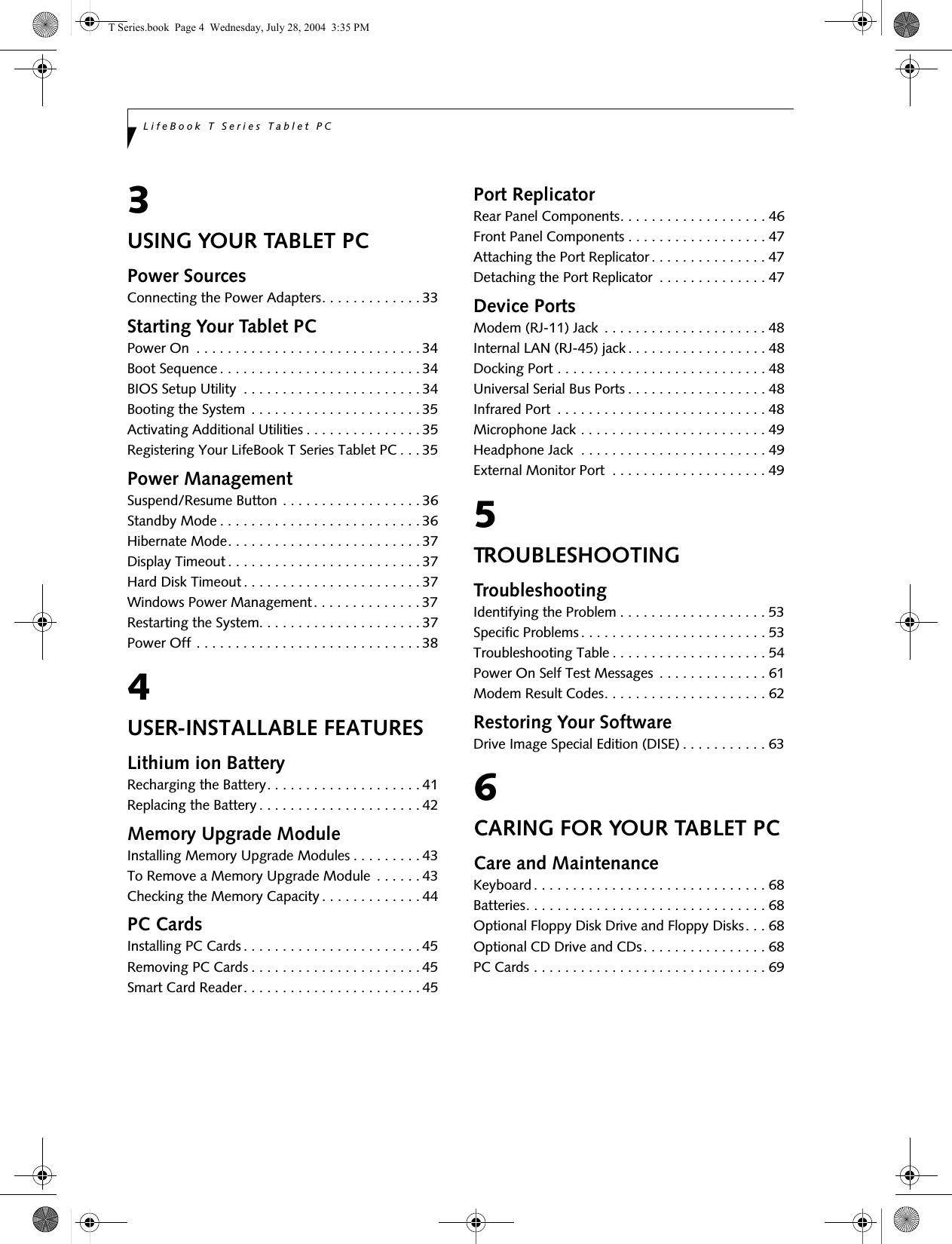
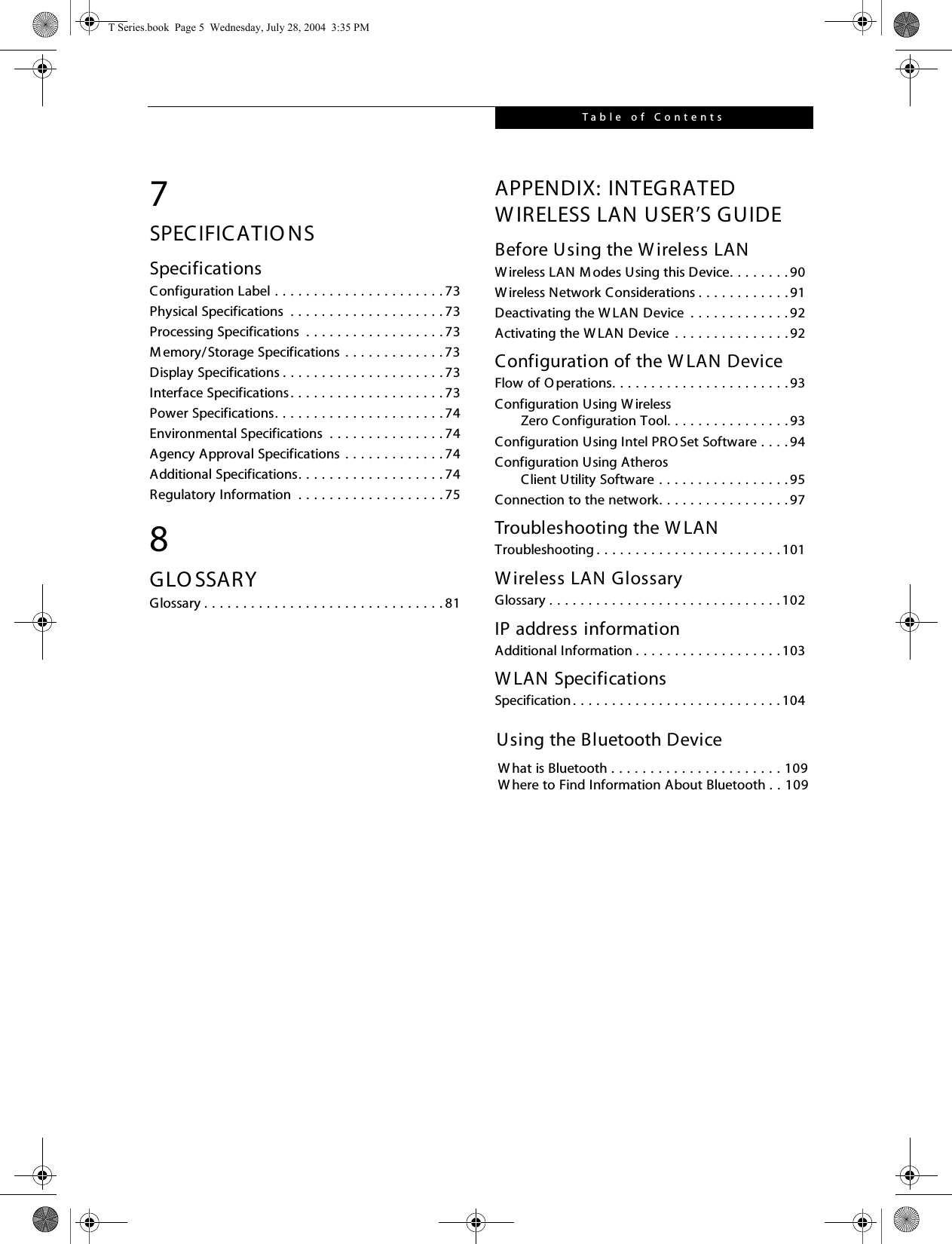
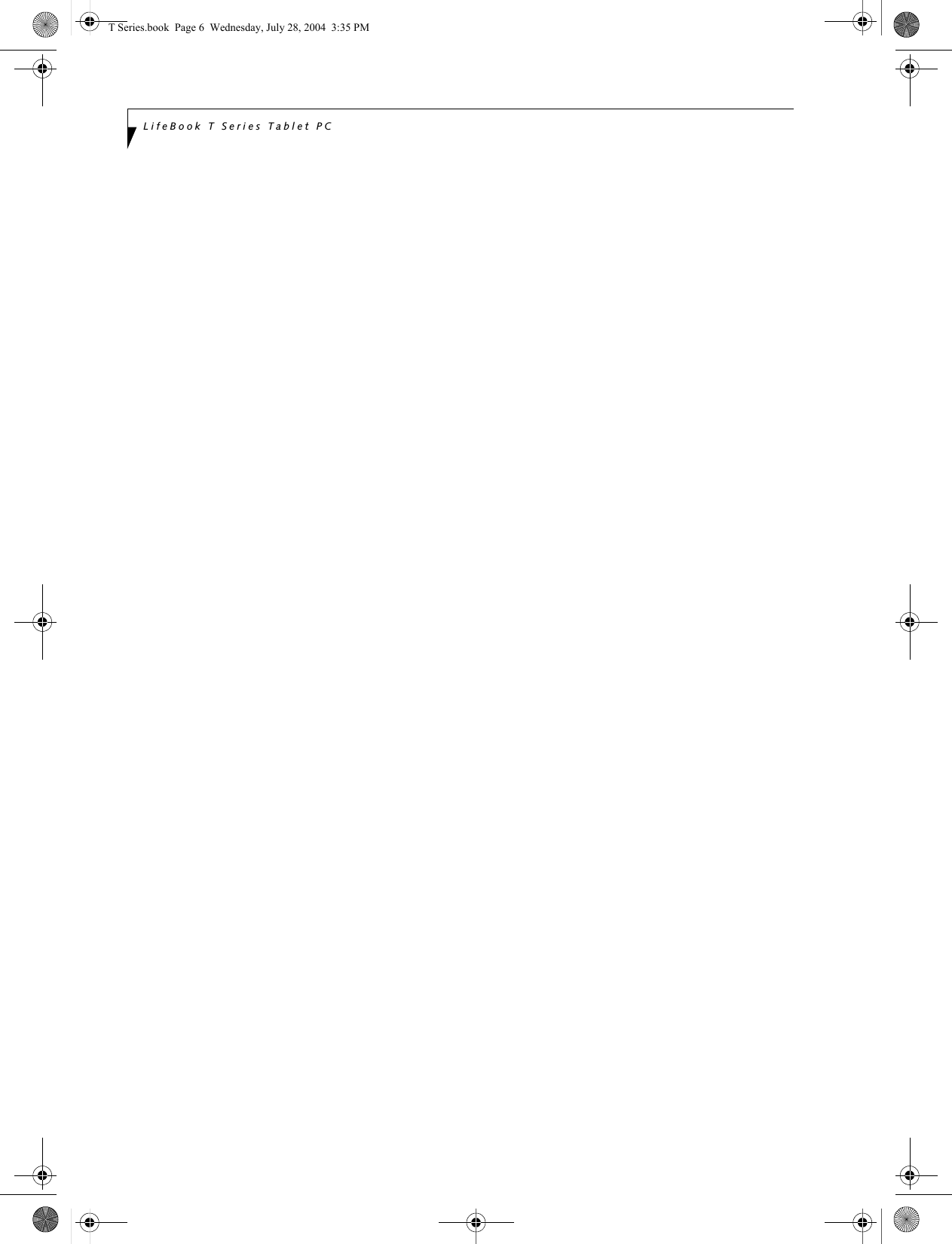
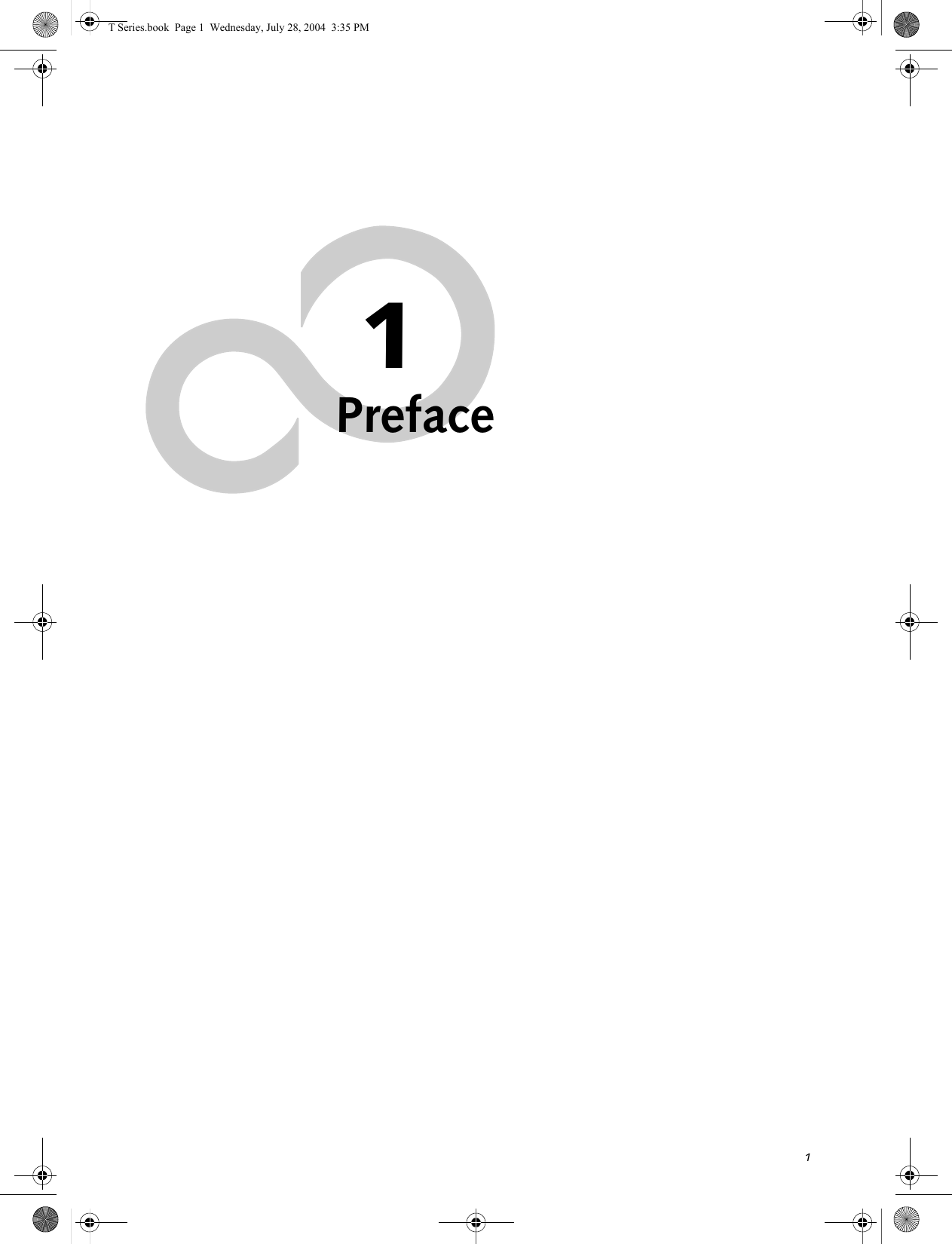
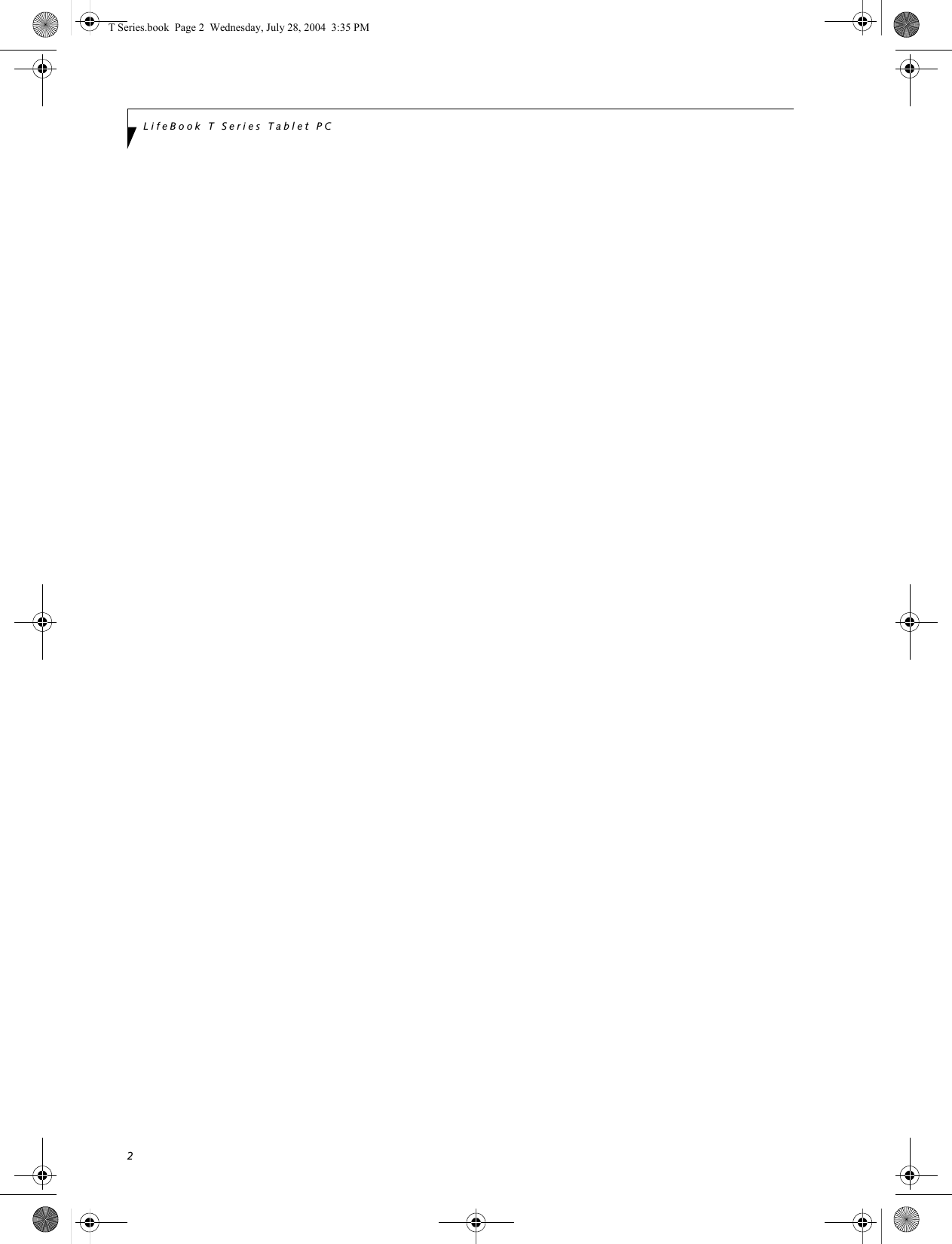
![3PrefacePrefaceABOUT THIS GUIDEThe LifeBook® T Series Tablet PC from Fujitsu Computer Systems Corporation is a powerful convert-ible computer. It can be used either as a standard note-book using keyboard input, or in tablet configuration using pen input. It is powered by an Intel® micropro-cessor, has a built-in color display with an active digi-tizer, and brings the computing power of desktop personal computers (PCs) to a portable and versatile environment.This manual explains how to operate your LifeBook T Series Tablet PC’s hardware and built-in system soft-ware. Your LifeBook T Series Tablet PC comes with Windows® XP Tablet Edition pre-installed.Your LifeBook T Series Tablet PC is a completely self-contained unit with an active-matrix (TFT) color LCD display. The display has a wide viewing angle and can be used indoors or outdoors. The tablet has a powerful interface that enables it to support a variety of optional features. Conventions Used in the GuideKeyboard keys appear in brackets. Example: [Fn], [F1], [Esc], [Enter] and [Ctrl].Pages with additional information about a specific topic are cross-referenced within the text.Example: (See page xx.)On screen buttons or menu items appear in bold.Example: Click OK to restart your Tablet PC.DOS commands you enter appear in Courier type. Example: Shutdown the computer?FUJITSU CONTACT INFORMATIONService and SupportYou can contact Fujitsu Computer Systems Service and Support the following ways:■Toll free: 1-800-8Fujitsu (1-800-838-5487)■Fax: 1-408-764-2724 ■E-mail: 8fujitsu@us.fujitsu.com ■Web site: http://us.fujitsu.com/computersBefore you place the call, you should have the following information ready so that the customer support representative can provide you with thefastest possible solution:■Product name■Product configuration number■Product serial number■Purchase date■Conditions under which the problem occurred■Any error messages that have occurred■Type of device connected, if anyFujitsu OnlineYou can go directly to the online Fujitsu Product catalog for your Tablet PC. Go to Start -> All Programs -> Service & Support Software, and click on Pen Accesso-ries Web site.You can also reach Fujitsu Service and Support online by going to Start -> All Programs -> Service & Support Software, and clicking on Fujitsu Service & Support Web site.WARRANTYYour LifeBook T Series Tablet PC is backed by an Inter-national Limited Warranty and includes toll-free tech-nical support. Check the service kit that came with yourTablet PC for warranty terms and conditions.The information icon highlights information that will enhance your understanding of the subject material.The caution icon highlights information that is important to the safe operation of your computer, or to the integrity of your files. Please read all caution information carefully.The warning icon highlights information that can be hazardous to either you, your system, or your files. Please read all warning information carefully.You must have an active internet connection to use the online URL links.T Series.book Page 3 Wednesday, July 28, 2004 3:35 PM](https://usermanual.wiki/Fujitsu-Client-Computing/WB0029.User-manual-part-1/User-Guide-546102-Page-10.png)
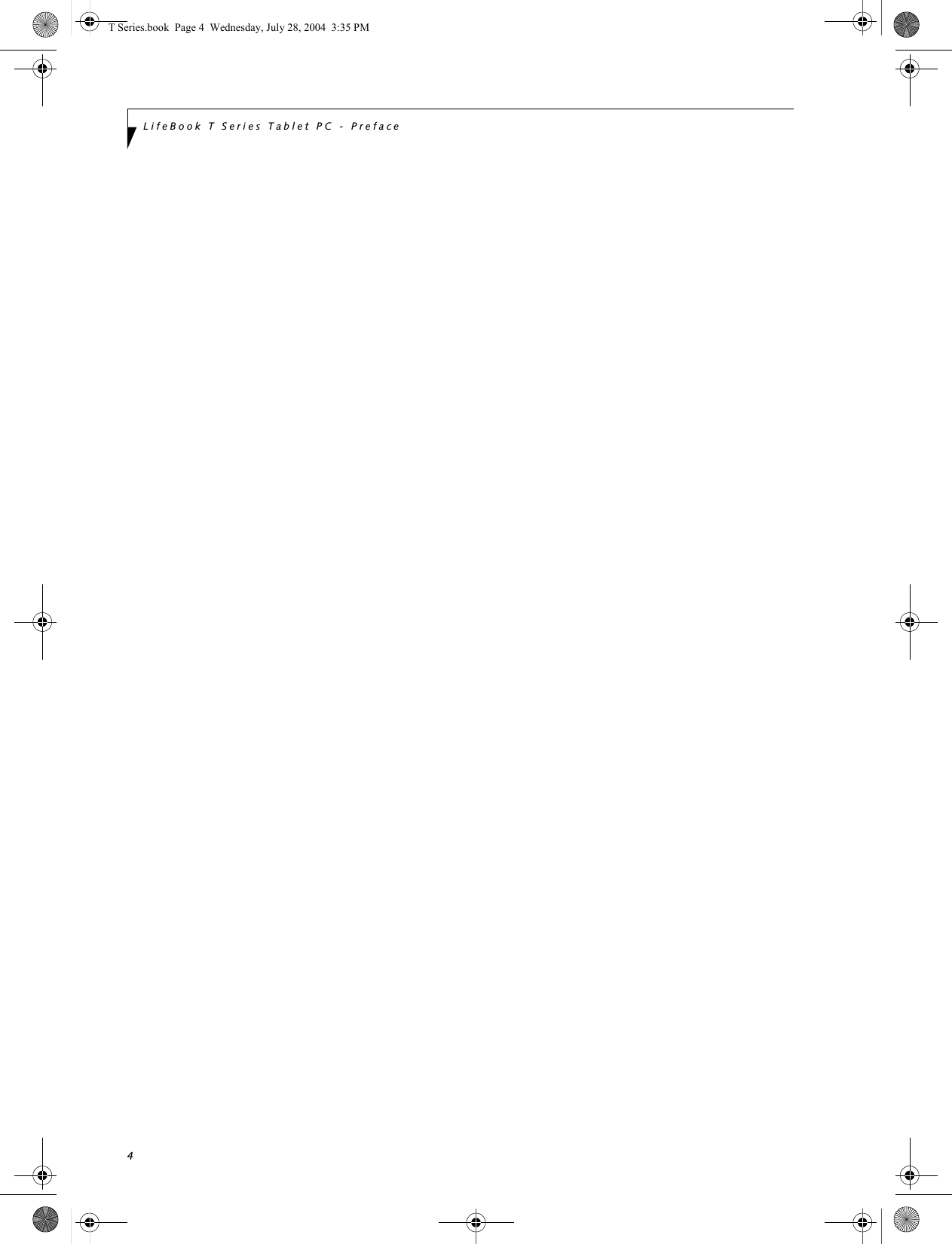
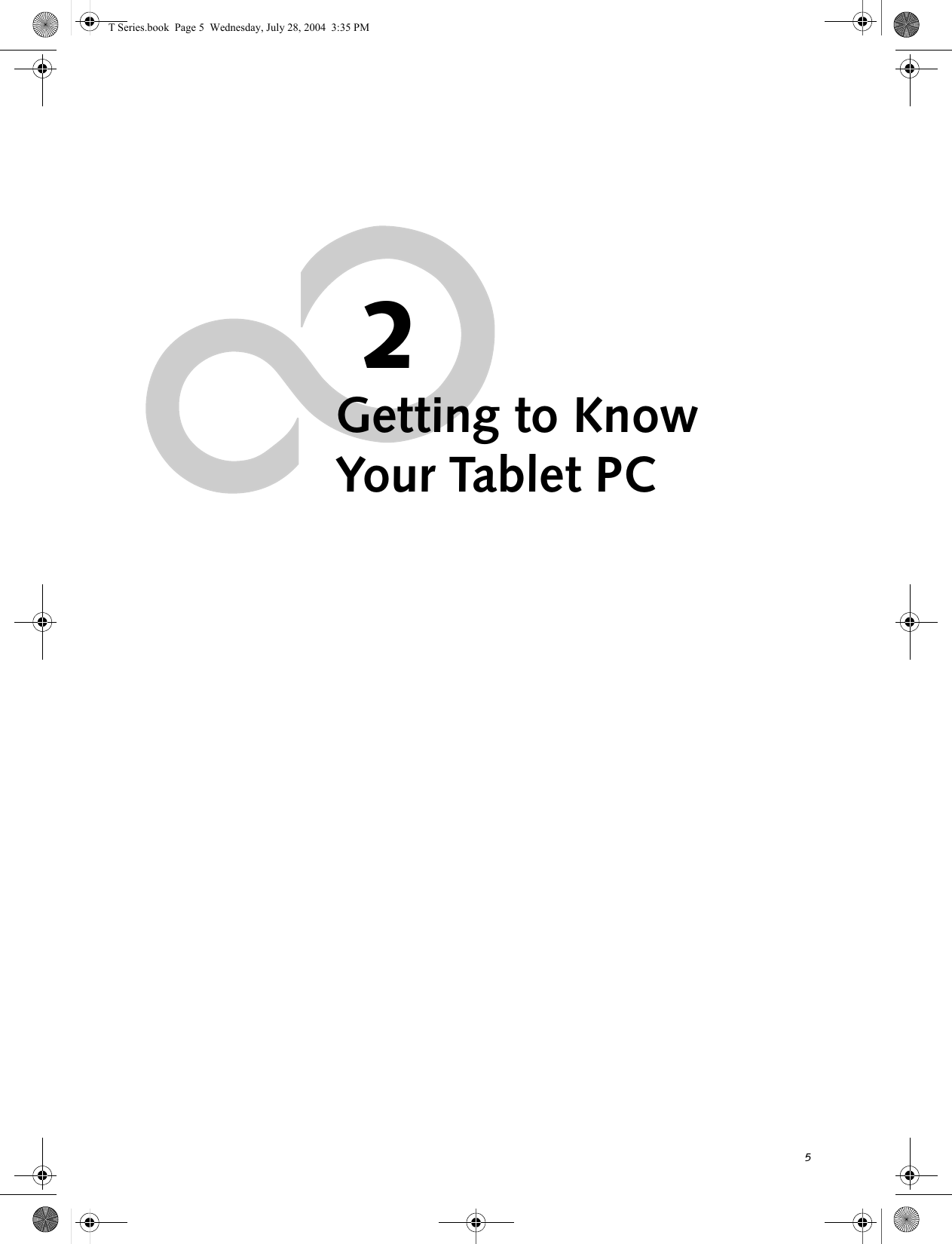
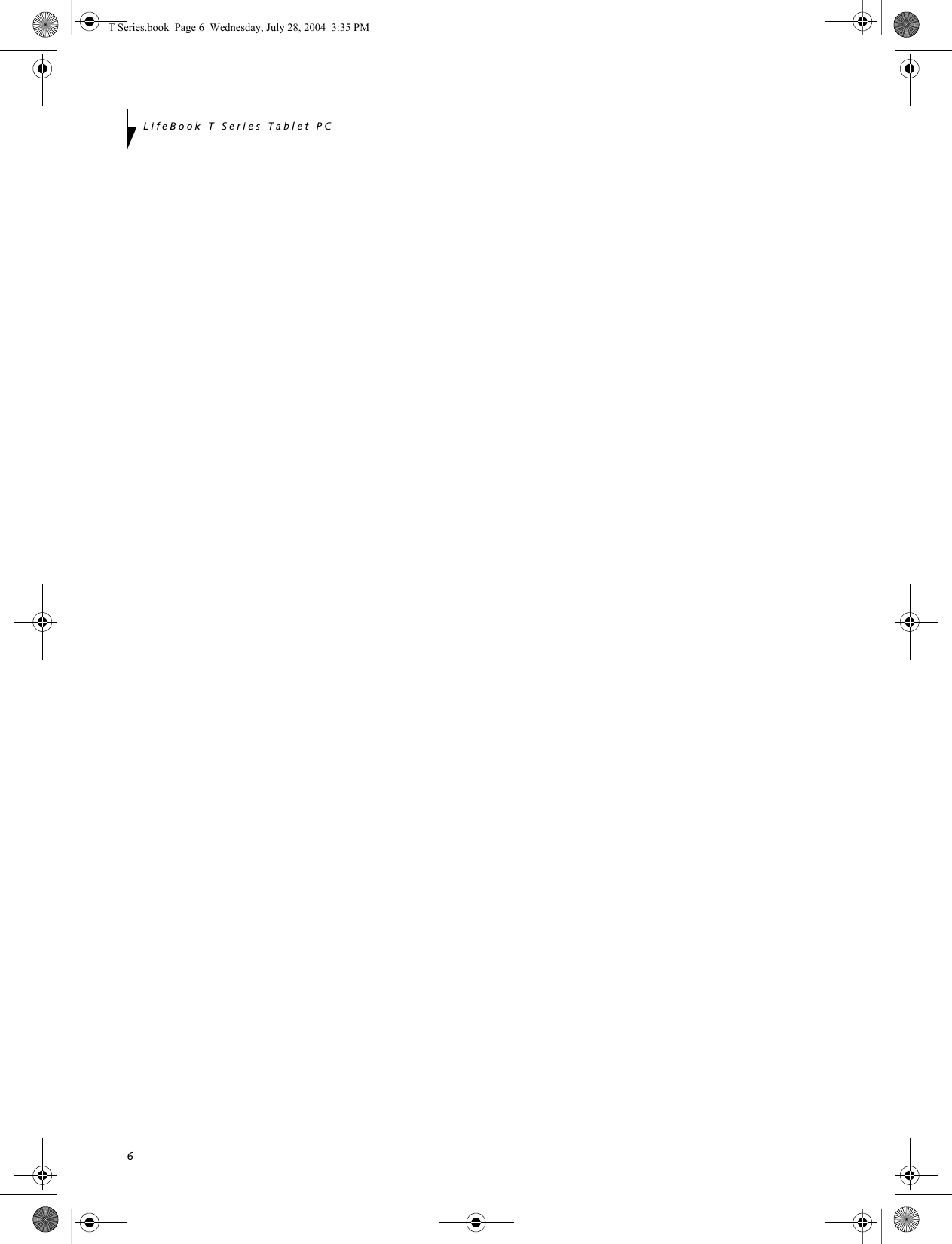
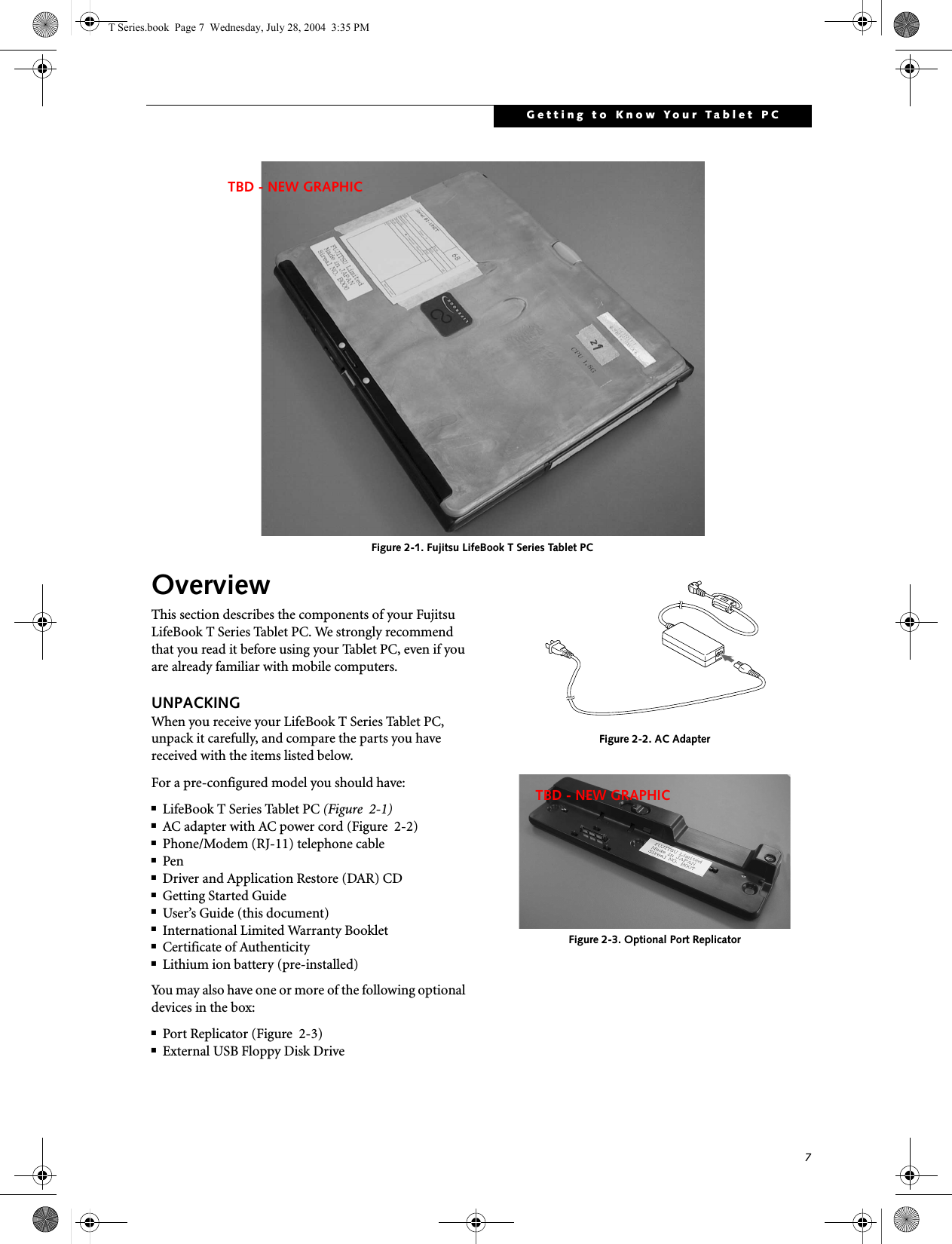
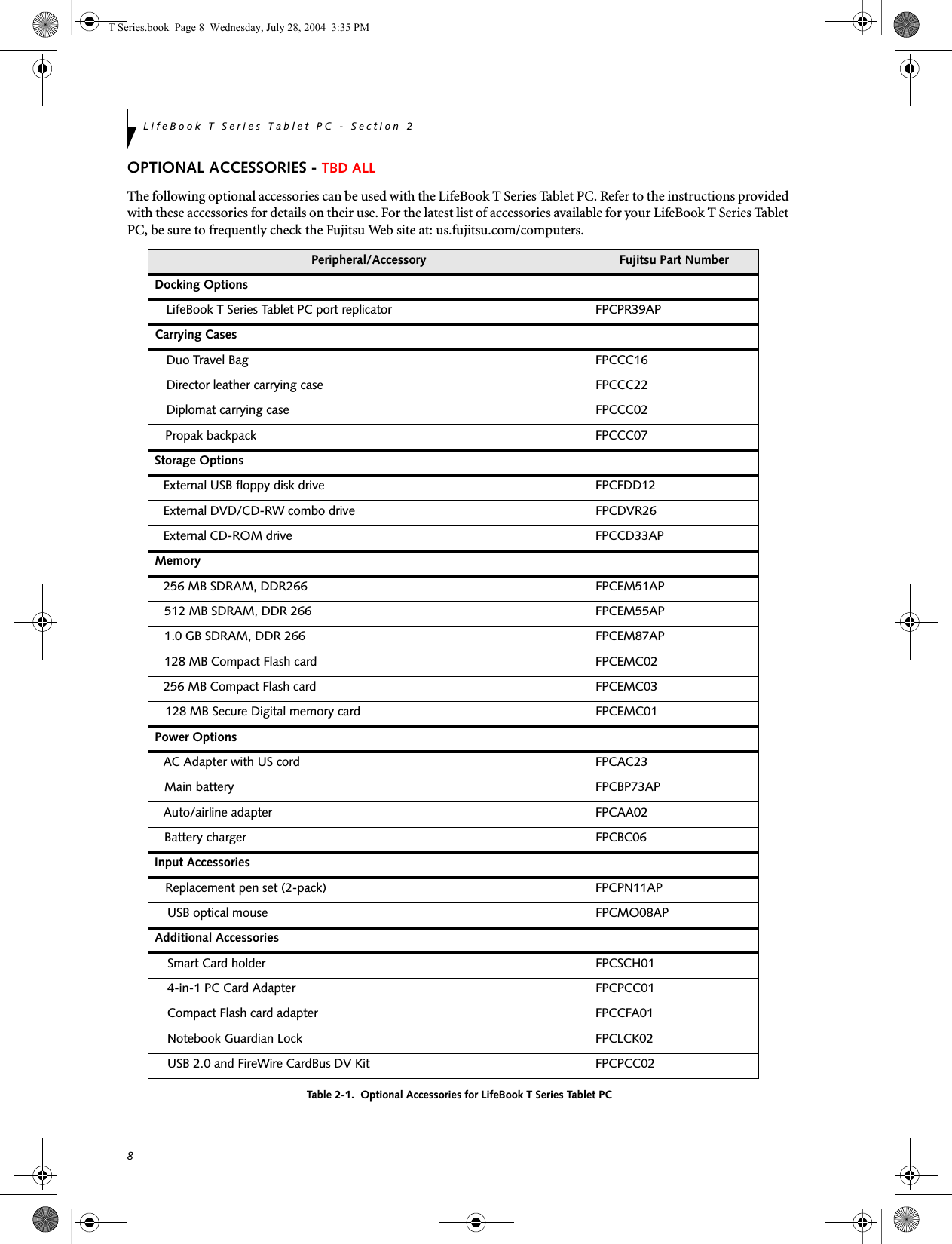
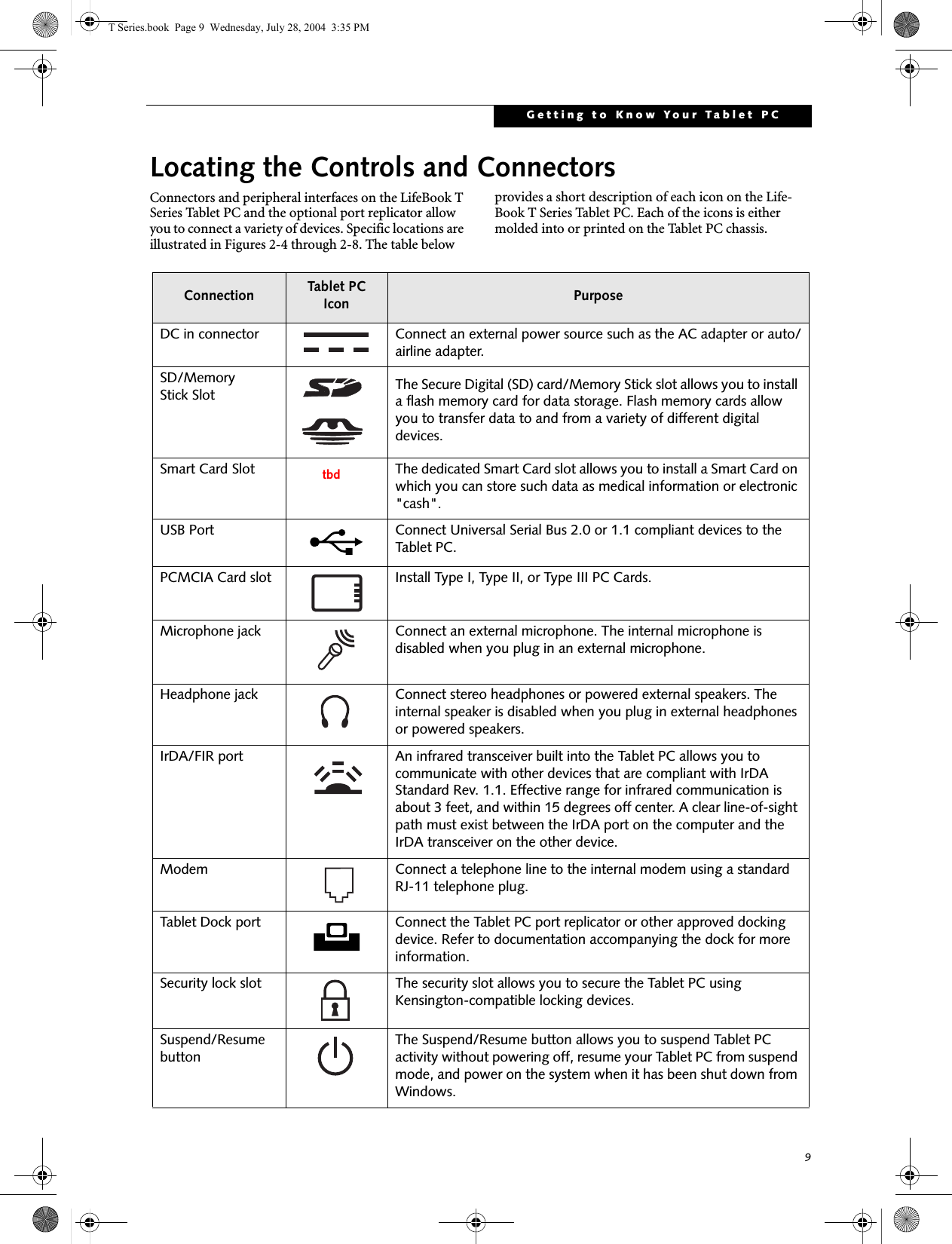
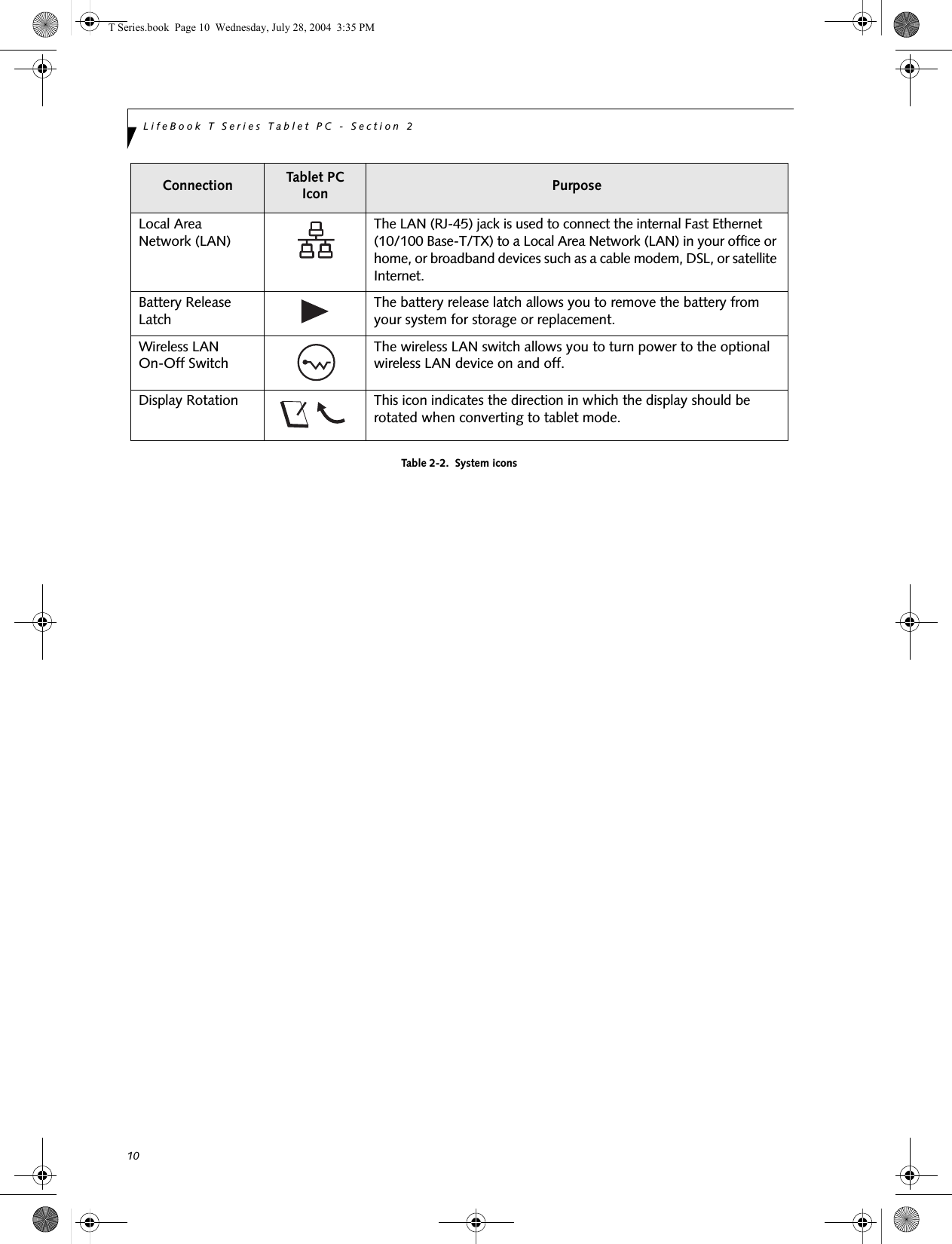
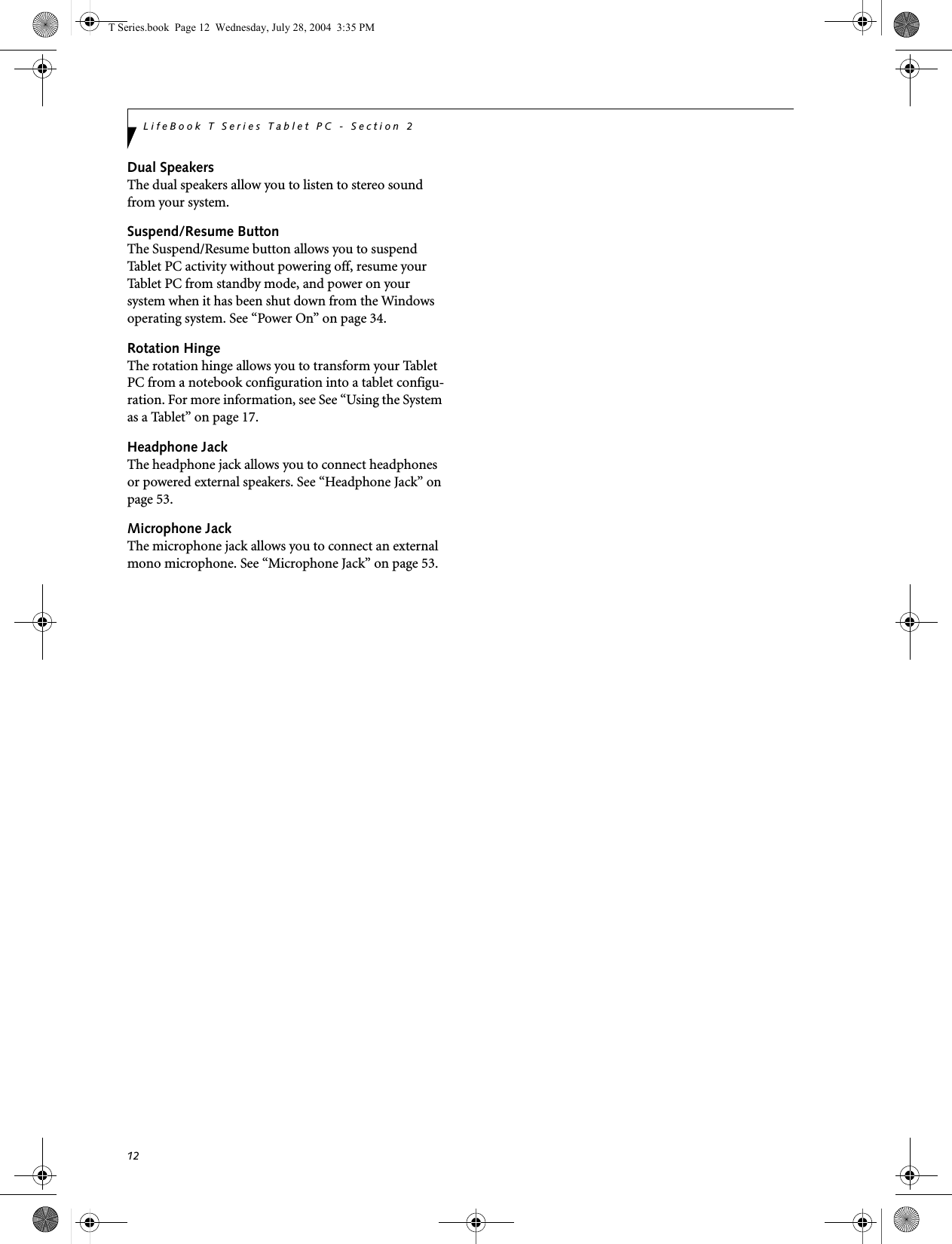
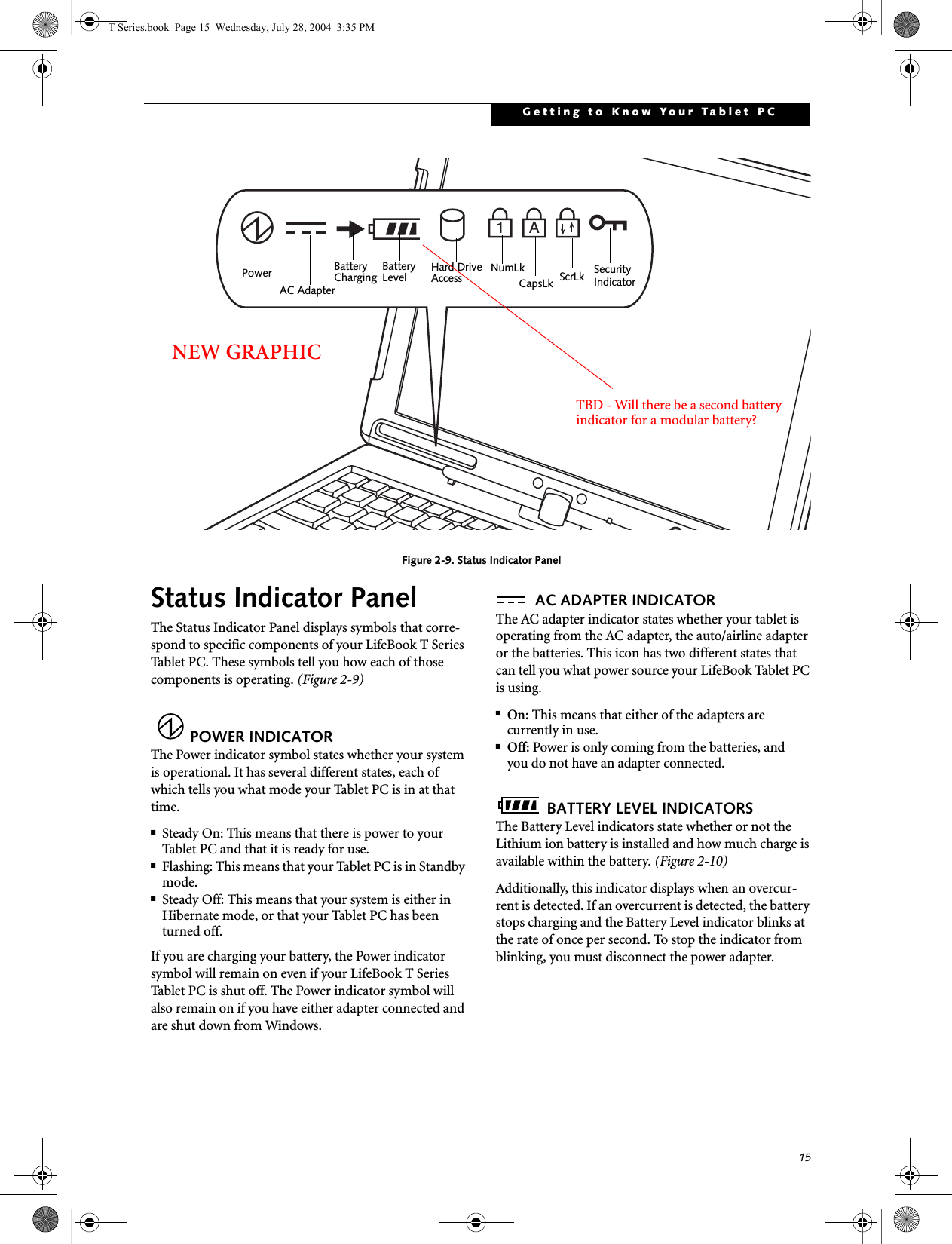
![16LifeBook T Series Tablet PC - Section TwoFigure 2-10. Battery Level IndicatorBATTERY CHARGING INDICATORLocated to the left of the Battery Level indicator is a small arrow symbol. This symbol states whether the battery is charging. This indicator will flash if the battery is too hot or cold to charge.HARD DRIVE ACCESS INDICATORThe Hard Drive Access indicator states whether your internal hard drive is being accessed.NUMLK INDICATORThe NumLk indicator states that the integral keyboard is set in ten-key numeric keypad mode. If there is no battery activity and the power adapters are not connected, the Battery Level indicators will also be off.CAPSLOCK INDICATORThe CapsLock indicator states that your keyboard is set to type in all capital letters. SCRLK INDICATORThe ScrLk indicator states that your scroll lock is active. SECURITY INDICATORThe Security Indicator flashes (if a password was set) when the system resumes from Off or Standby modes. You must enter the password that was set in the Security Panel before your system will resume operation.A shorted battery is damaged and must be replaced. (Figure 2-10) If there is no battery activity and the power adapters are not connected, the Battery Level indicators will also be off.Batteries subjected to shocks, vibration or extreme temperatures can be permanently damaged.76%–100% Charging76%–100%51%–75%26%–50%11%–25%Low Warning <11%Critical Low or Dead BatteryShorted BatteryIf you are using the optional external numerical keypad, pressing the [NumLk] key will activate the external keypad. The indicator will come on, however it will not change any of the functionality of your keyboard keys.T Series.book Page 16 Wednesday, July 28, 2004 3:35 PM](https://usermanual.wiki/Fujitsu-Client-Computing/WB0029.User-manual-part-1/User-Guide-546102-Page-20.png)
![19Getting to Know Your Tablet PCFigure 2-17. KeyboardKeyboardUSING THE KEYBOARDYour LifeBook T Series Tablet PC has an integral 83-key keyboard. The keys perform all the standard functions of a 101-key keyboard, including the Windows keys and other special function keys. This section describes the following keys. (Figure 2-17)■Numeric keypad: Your Tablet PC allows certain keys to serve dual purposes, both as standard characters and as numeric and mathematical keys. The ability to tog-gle between the standard character and numerical keys is controlled through the [NumLk] key.■Cursor keys: Your keyboard contains four arrowkeys for moving the cursor or insertion point to the right, left, up, or down within windows, applications and documents. ■Function keys: The keys labeled [F1] through [F12], are used in conjunction with the [Fn] key to produce special actions that vary depending on what program is running. ■Windows keys: These keys work with your Windows operating system and function the same as the onscreen Start menu button, or the right button on your pointing device.NUMERIC KEYPADCertain keys on the keyboard perform dual functions as both standard character keys and numeric keypad keys. NumLk can be activated by pressing the [NumLk] key. Turning off the NumLk feature is done the same way. Once this feature is activated you can enter numerals 0 through 9, perform addition ( + ), subtraction ( - ),multiplication ( * ), or division ( / ), and enter decimal points ( . ) using the keys designated as ten-key function keys. The keys in the numeric keypad are marked on the front edge of the key to indicate their secondary func-tions. (Figure 2-17) WINDOWS KEYSYour LifeBook T Series Tablet PC has two Windows keys: a Start key and an Application key. The Start key displays the Start menu. This button functions the same as your onscreen Start menu button. The Application key functions the same as your right mouse button and displays shortcut menus for the selected item. (Please refer to your Windows documentation for additional information regarding the Windows keys.) (Figure 2-17)EndHomeFn Key Start KeyFunction KeysNumeric KeypadApplication KeyCursor Keys(outlined with thickblack line)If you are using the optional external numerical keypad, pressing the [NumLk] key will activate the external keypad. The indicator will come on, however it will not change any of the functionality of your keyboard keys. T Series.book Page 19 Wednesday, July 28, 2004 3:35 PM](https://usermanual.wiki/Fujitsu-Client-Computing/WB0029.User-manual-part-1/User-Guide-546102-Page-21.png)
![20LifeBook T Series Tablet PC - Section TwoCURSOR KEYSThe cursor keys are the four arrow keys on the keyboard which allow you to move the cursor up, down, left, and right in applications. In programs such as Windows Explorer, it moves the “focus” (selects the next item up, down, left, or right). (Figure 2-17)FUNCTION KEYSYour Tablet PC has 12 function keys, F1 through F12. The functions assigned to these keys differ for each application. You should refer to your software documen-tation to find out how these keys are used. (Figure 2-17)[Fn] KeyThe [Fn] key provides extended functions for theTablet PC and is always used in conjunction with another key. ■[Fn+F3]: Pressing [F3] while holding [Fn] will toggle the Audio Mute on and off.■[Fn+F4]: Pressing [F4] while holding [Fn] will toggle the built-in pointing device on and off. Note that the [Fn+F4] combination only works if Manual Setting is selected in the BIOS. (See “Entering the BIOS Setup Utility” on page 34)■[Fn +F5]: Pressing [F5] while holding [Fn] allows you to toggle between video compensation and no compensation. (Video compensation controls spacing on the display. When it is enabled, displays with less than 1024 x 768 or 800 x 600 pixel resolution will still cover the entire screen.)■[Fn+F6]: Pressing [F6] repeatedly while holding [Fn] will lower the brightness of your display. Note that adjusting the brightness using the keyboard changes the system setting.■[Fn+F7]: Pressing [F7] repeatedly while holding [Fn] will increase the brightness of the display.■[Fn+F8]: Pressing [F8] repeatedly while holding [Fn] will decrease the volume of your Tablet PC.■[Fn+F9]: Pressing [F9] repeatedly while holding [Fn] will increase the volume of your Tablet PC.■[Fn+F10]: Pressing [F10] while holding [Fn] allows you to change your selection of where to send your display video. Each time you press the combination of keys you will step to the next choice. The choices, in order, are: built-in display panel only, both built-in display panel, and external monitor or external moni-tor only.T Series.book Page 20 Wednesday, July 28, 2004 3:35 PM](https://usermanual.wiki/Fujitsu-Client-Computing/WB0029.User-manual-part-1/User-Guide-546102-Page-22.png)
![21Getting to Know Your Tablet PCFigure 2-18. LifeBook T Series Tablet PC Security/Tablet PC Buttons LifeBook Security/Tablet PC ButtonsA unique feature of your LifeBook T Series Tablet PC is the array of Security and Tablet PC buttons. These buttons allow you to secure your Tablet PC from unauthorized use and to launch specific applications with the touch of a button. If the security system is activated, upon starting your Tablet PC or resuming from Standby, Hibernate, or shut-down mode the security system will require you to enter a password code using the security buttons. After you enter the correct password, your Tablet PC will resume operation. The five security/Tablet PC buttons are located on the bottom right-hand side of the display when it is config-ured to be used as a notebook. (Figure 2-18) Security functions: All five buttons are used when implementing security functions. Four of the buttons are used to enter the password, and the fifth is used as an Enter button. See the right-hand column of Table 2-3.Tablet PC functions: All five of the buttons have primary functions. Four of the buttons have secondary functions when used as application buttons. The secondary functions are activated by pressing the Func-tion (Fn) button while pressing the application button. See Table 2-3 for specific functions. The secondary func-tions of the Application A and B buttons can be changed to launch any application. See “Changing Tablet PC Button Functions” on page 22 Table 2-3. Security/Tablet PC Button Functions(1) Application A Button(3) Button 3(2) Application B Button(4) Button 4Enter ButtonNEW GRAPHICWhen the system is logging on or when it is locked (i.e., when you have the Logon or Computer Locked window showing on your desktop), the A and B buttons act as [Tab] and [Enter] keys, respectively. Button Icon Primary Function Secondary Function(Fn + Button)Security Panel Function(Pre-boot and resuming from suspend)Page Down User-defined Application A(Default = Calculator) Security Button 1Page Up User-Defined Application B(Default = MS Journal) Security Button 2Screen Rotation VGA-Out Security Button 3Secondary Function Selection Fujitsu Menu Utility Security Button 4Ctl+Alt+Del Button None Security Enter ButtonT Series.book Page 21 Wednesday, July 28, 2004 3:35 PM](https://usermanual.wiki/Fujitsu-Client-Computing/WB0029.User-manual-part-1/User-Guide-546102-Page-23.png)
![22LifeBook T Series Tablet PC - Section TwoPage Down / Application A ButtonWhen you press the Page Down button when the system is running, each press of the button will scroll the screen down one frame. This allows you to navigate quickly through large documents.When you press the Fn button while you press then release the Page Down/Application A button, you will automatically start whichever program is assigned to the button. The default application for this button is Calcu-lator.See “Changing Tablet PC Button Functions” on page 22 to select a different application for this button.Page Up / Application B ButtonWhen you press the Page Up button when the system is running, each press of the button will scroll the screen up one frame. This allows you to navigate quickly through large documents.When you press the Fn button while you press then release the Page Up/Application A button, you will auto-matically start whichever program is assigned to the button. The default application for this button is Microsoft Journal.See “Changing Tablet PC Button Functions” on page 22 to select a different application for this button.Screen Rotation / VGA-Out ButtonThe screen rotation feature would normally be used only when the system is configured as a tablet. When you would like to use the tablet as an eBook, for example, you would use the portrait orientation; when accessing spreadsheets or using the system as a notebook, you would more typically use landscape orientation.When the system is changed to tablet configuration, the orientation automatically changes to portrait mode by default. When you press the Screen Rotation / VGA-Out button, the system screen orientation changes from portrait (vertical) to landscape (horizontal) or from landscape to portrait. Function / Fujitsu Menu Utility ButtonThe Function button works in conjunction with the other application buttons to provide additional func-tionality for the buttons. Refer to specific details above.Pressing the Fn button twice in succession causes the Fujitsu Menu Utility to appear on your screen, allowing you to modify certain system settings.Ctl+Alt+Del ButtonPressing and holding the Ctl-Alt-Del button for up to 750 msecs launches the Logon screen or the Windows Task Manager (if the system hasn’t yet been configured).CHANGING TABLET PC BUTTON FUNCTIONSThe Application A and B buttons can be changed to launch a program or perform an action you select. By default, the Application A button launches the Calcu-lator, and the Application B button launches MS Journal.To launch different applications or cause the Application A or B buttons to perform a specific action:1. Double-click on the Tablet and Pen Settings icon in the Control Panel. 2. Select the Tablet Buttons tab and select the button you would like to change from the list.3. Click [Change] and open the drop down list in the Action: field.4. Select the action you would like the button to perform. If you want to launch a program, click on Launch an Application then browse to the location of the program.5. Click [OK], then click [OK] again. The buttons will now perform the actions you have assigned to them.SETTING UP LIFEBOOK SECURITY PANELWhen you receive your Tablet PC, the security panel application is pre-installed without any passwords. The following sections provide detailed information on your security panel, how to set, change or remove passwords.Numbered ButtonsUse these buttons to enter your password.(Figure 2-18)Enter ButtonAfter entering the button strokes, push this button to enter the password into the Tablet PC. (Figure 2-18)PASSWORDSThe user and supervisor password may be set on this Tablet PC. A supervisor password is typically the same for all Tablet PC’s and notebooks in a work group, office, or company to allow for system management. Individual computers in a group environment should not use a common password. A password consists of one to five button strokes plus the enter button. A valid stroke consists of pushing one or up to four buttons simulta-neously. The screen orientation default can be changed by going to the Control Panel and double-clicking on the Fujitsu Display Control icon and selecting the desired defaults from the Display Orientation section. After changing the defaults, click [OK]. T Series.book Page 22 Wednesday, July 28, 2004 3:35 PM](https://usermanual.wiki/Fujitsu-Client-Computing/WB0029.User-manual-part-1/User-Guide-546102-Page-24.png)